Entry Database : PDB / ID : 4giqTitle Crystal Structure of mouse RANK bound to RANKL (Tumor necrosis factor ...) x 2 Keywords / / / / / / / / / / Function / homology Function Domain/homology Component
/ / / / / / / / / / / / / / / / / / / / / / / / / / / / / / / / / / / / / / / / / / / / / / / / / / / / / / / / / / / / / / / / / / / / / / / / / / / / / / / / / / / / / / / / / / / / / / / / / / / / / / / / Biological species Mus musculus (house mouse)Method / / / Resolution : 2.7 Å Authors Nelson, C.A. / Wang, M.W.-H. / Fremont, D.H. Journal : Structure / Year : 2012Title : RANKL Employs Distinct Binding Modes to Engage RANK and the Osteoprotegerin Decoy Receptor.Authors : Nelson, C.A. / Warren, J.T. / Wang, M.W. / Teitelbaum, S.L. / Fremont, D.H. History Deposition Aug 8, 2012 Deposition site / Processing site Revision 1.0 Oct 24, 2012 Provider / Type Revision 1.1 Nov 28, 2012 Group Revision 1.2 Feb 13, 2013 Group Revision 1.3 Nov 15, 2017 Group / Category / Item Revision 1.4 Jul 29, 2020 Group Data collection / Database references ... Data collection / Database references / Derived calculations / Structure summary Category chem_comp / entity ... chem_comp / entity / pdbx_chem_comp_identifier / pdbx_entity_nonpoly / pdbx_struct_conn_angle / struct_conn / struct_ref_seq_dif / struct_site / struct_site_gen Item _chem_comp.name / _chem_comp.type ... _chem_comp.name / _chem_comp.type / _entity.pdbx_description / _pdbx_entity_nonpoly.name / _pdbx_struct_conn_angle.ptnr1_auth_comp_id / _pdbx_struct_conn_angle.ptnr1_auth_seq_id / _pdbx_struct_conn_angle.ptnr1_label_atom_id / _pdbx_struct_conn_angle.ptnr1_label_comp_id / _pdbx_struct_conn_angle.ptnr1_label_seq_id / _pdbx_struct_conn_angle.ptnr3_auth_comp_id / _pdbx_struct_conn_angle.ptnr3_auth_seq_id / _pdbx_struct_conn_angle.ptnr3_label_atom_id / _pdbx_struct_conn_angle.ptnr3_label_comp_id / _pdbx_struct_conn_angle.ptnr3_label_seq_id / _pdbx_struct_conn_angle.value / _struct_conn.pdbx_dist_value / _struct_conn.pdbx_leaving_atom_flag / _struct_conn.pdbx_role / _struct_conn.ptnr1_auth_comp_id / _struct_conn.ptnr1_auth_seq_id / _struct_conn.ptnr1_label_atom_id / _struct_conn.ptnr1_label_comp_id / _struct_conn.ptnr1_label_seq_id / _struct_ref_seq_dif.details Description / Provider / Type Revision 1.5 Sep 13, 2023 Group Data collection / Database references ... Data collection / Database references / Refinement description / Structure summary Category chem_comp / chem_comp_atom ... chem_comp / chem_comp_atom / chem_comp_bond / database_2 / pdbx_initial_refinement_model Item / _database_2.pdbx_DOI / _database_2.pdbx_database_accessionRevision 1.6 Oct 16, 2024 Group / Category / pdbx_modification_feature
Show all Show less
 Open data
Open data Basic information
Basic information Components
Components Keywords
Keywords Function and homology information
Function and homology information
 X-RAY DIFFRACTION /
X-RAY DIFFRACTION /  MOLECULAR REPLACEMENT /
MOLECULAR REPLACEMENT /  molecular replacement / Resolution: 2.7 Å
molecular replacement / Resolution: 2.7 Å  Authors
Authors Citation
Citation Journal: Structure / Year: 2012
Journal: Structure / Year: 2012 Structure visualization
Structure visualization Molmil
Molmil Jmol/JSmol
Jmol/JSmol Downloads & links
Downloads & links Download
Download 4giq.cif.gz
4giq.cif.gz PDBx/mmCIF format
PDBx/mmCIF format pdb4giq.ent.gz
pdb4giq.ent.gz PDB format
PDB format 4giq.json.gz
4giq.json.gz PDBx/mmJSON format
PDBx/mmJSON format Other downloads
Other downloads 4giq_validation.pdf.gz
4giq_validation.pdf.gz wwPDB validaton report
wwPDB validaton report 4giq_full_validation.pdf.gz
4giq_full_validation.pdf.gz 4giq_validation.xml.gz
4giq_validation.xml.gz 4giq_validation.cif.gz
4giq_validation.cif.gz https://data.pdbj.org/pub/pdb/validation_reports/gi/4giq
https://data.pdbj.org/pub/pdb/validation_reports/gi/4giq ftp://data.pdbj.org/pub/pdb/validation_reports/gi/4giq
ftp://data.pdbj.org/pub/pdb/validation_reports/gi/4giq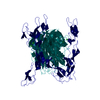
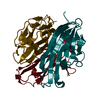
 Links
Links Assembly
Assembly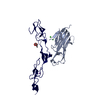
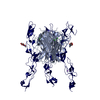
 Components
Components


 unidentified baculovirus / References: UniProt: O35305
unidentified baculovirus / References: UniProt: O35305





 X-RAY DIFFRACTION / Number of used crystals: 1
X-RAY DIFFRACTION / Number of used crystals: 1  Sample preparation
Sample preparation ROTATING ANODE / Type: RIGAKU RUH3R / Wavelength: 1.5418 Å
ROTATING ANODE / Type: RIGAKU RUH3R / Wavelength: 1.5418 Å molecular replacement
molecular replacement Processing
Processing MOLECULAR REPLACEMENT
MOLECULAR REPLACEMENT Movie
Movie Controller
Controller




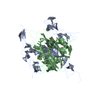
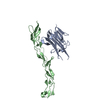
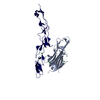
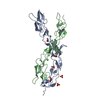
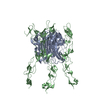
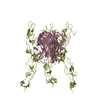
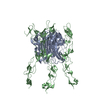
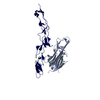
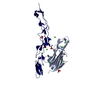


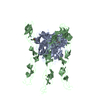
 PDBj
PDBj




